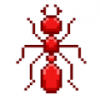- Formiculture.com
- Forums
- Gallery
- Members
- Member Map
- Chat

State College, PA, USA, July 8, 2016
Started By
Works4TheGood
, Jul 8 2016 7:17 PM
4 replies to this topic
#1
 Offline
-
Posted July 8 2016 - 7:17 PM
Offline
-
Posted July 8 2016 - 7:17 PM
Location: State College, PA. Found drowning in a suburban swimming pool.
Size: 11mm
See pics for more detail.
I caught 7 of these, all of which had fallen into the pool at night, or very early morning
Pics:
http://www.formicult...587-ant-id-req/
Size: 11mm
See pics for more detail.
I caught 7 of these, all of which had fallen into the pool at night, or very early morning
Pics:
http://www.formicult...587-ant-id-req/
~Dan
#2
 Offline
-
Posted July 8 2016 - 7:36 PM
Offline
-
Posted July 8 2016 - 7:36 PM
This is Tetramorium sp. E
#3
 Offline
-
Posted July 8 2016 - 7:37 PM
Offline
-
Posted July 8 2016 - 7:37 PM
Tetramorium sp.
I think they used to be called T. caespitum across the US but last I heard a few years ago it was discovered that actually there are a whole bunch of similar looking Tetramorium species in the US that aren't actually the same species for whatever systematics reasons.
Regardless, you can say that you have found some Tetramorium caespitum and everyone will know what you're talking about.
Edit: Or T. sp. E, though I think there is a complex of species with varying letter names in the US and you're not guaranteed to have the sp. E version of that complex.
Hopefully someone with more accurate or specific knowledge on this will come and tell me how wrong I am for our mutual benefit.
Edited by Reacker, July 8 2016 - 7:40 PM.
#4
 Offline
-
Posted July 8 2016 - 8:39 PM
Offline
-
Posted July 8 2016 - 8:39 PM
Great! Thanks for the quick responses! Wow! My first Tetramorium queens!
~Dan
#5
 Offline
-
Posted July 9 2016 - 5:59 AM
Offline
-
Posted July 9 2016 - 5:59 AM
Tetramorium sp. E is more or less a catchall for the complex of Tetramorium we previously thought to be T. caespitum. There are several Tetramorium species which are morphologically identical, fairly ubiquitous and non-native to North America, but genetically distinct from one another.
Edited by Batspiderfish, July 9 2016 - 6:00 AM.
If you've enjoyed using my expertise and identifications, please do not create undue ecological risk by releasing your ants. The environment which we keep our pet insects is alien and oftentimes unsanitary, so ensure that wild populations stay safe by giving your ants the best care you can manage for the rest of their lives, as we must do with any other pet.
Exotic ants are for those who think that vibrant diversity is something you need to pay money to see. It is illegal to transport live ants across state lines.
----
Black lives still matter.
1 user(s) are reading this topic
0 members, 1 guests, 0 anonymous users















